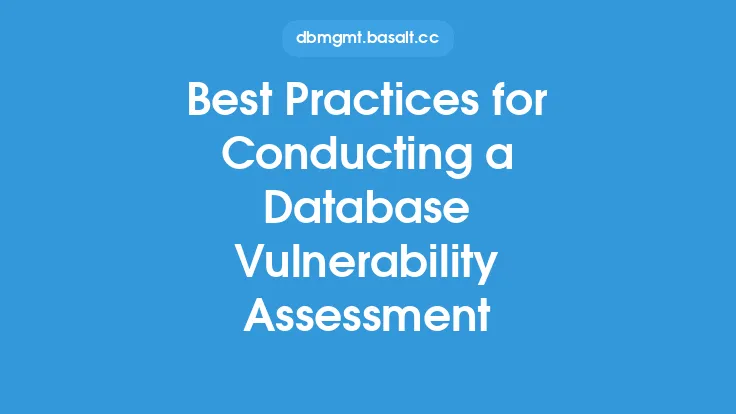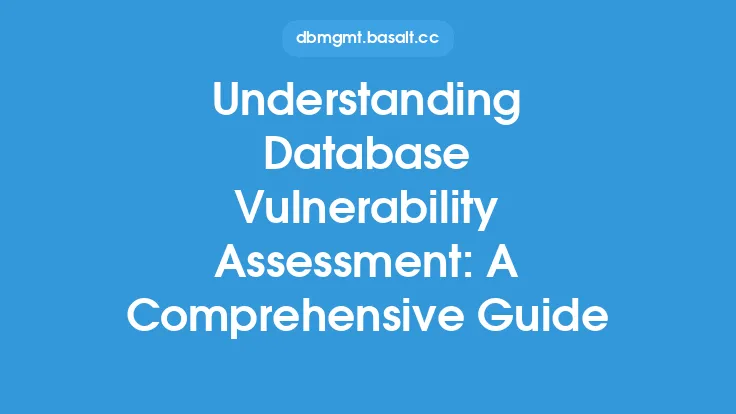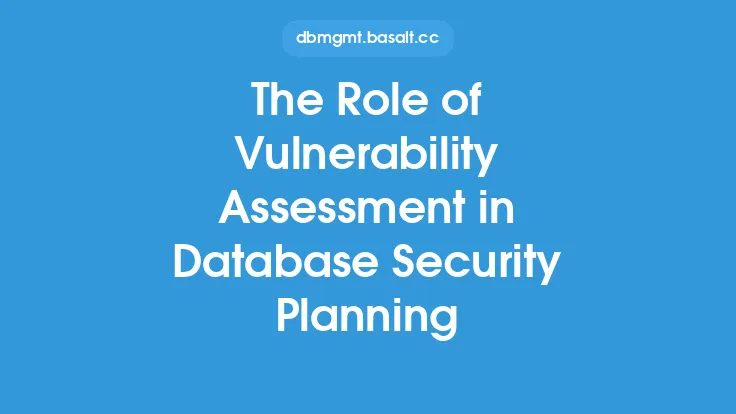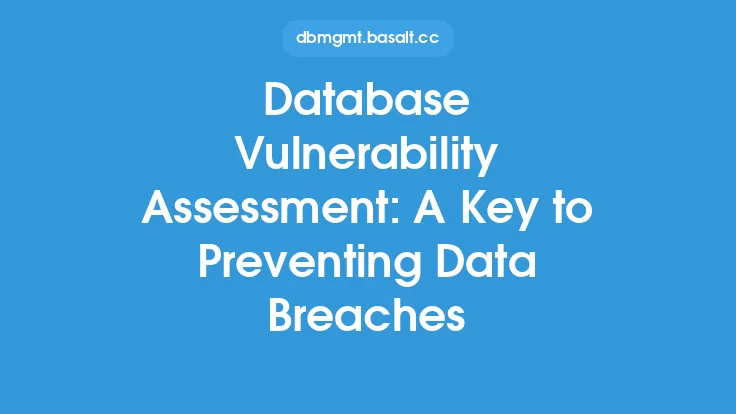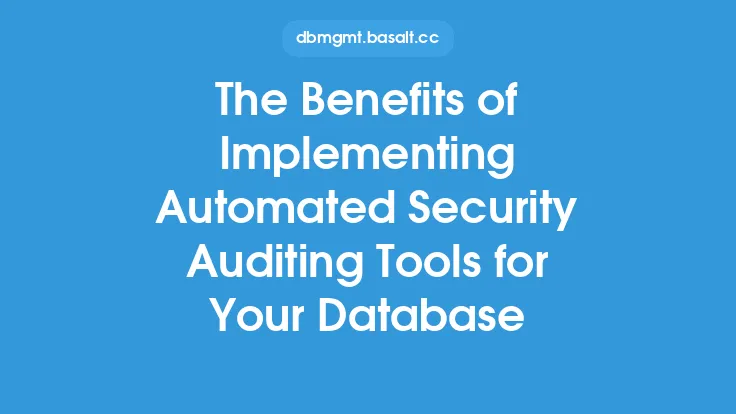Database security is a critical aspect of any organization's overall security posture, and vulnerability assessment tools play a vital role in identifying and remediating potential security threats. With the increasing complexity of database systems and the growing number of cyber threats, it's essential to have the right tools in place to ensure the security and integrity of sensitive data. In this article, we'll delve into the world of vulnerability assessment tools for database security, exploring their features, benefits, and comparison.
Introduction to Vulnerability Assessment Tools
Vulnerability assessment tools are designed to identify, classify, and prioritize potential security vulnerabilities in database systems. These tools use various techniques, such as network scanning, configuration analysis, and penetration testing, to detect weaknesses and provide recommendations for remediation. The goal of vulnerability assessment tools is to help organizations proactively identify and address potential security threats before they can be exploited by attackers.
Types of Vulnerability Assessment Tools
There are several types of vulnerability assessment tools available, each with its own strengths and weaknesses. Some of the most common types include:
- Network-based vulnerability scanners: These tools scan the network for open ports, services, and protocols, and identify potential vulnerabilities based on known exploits and vulnerabilities.
- Host-based vulnerability scanners: These tools scan the database server and its operating system for potential vulnerabilities, such as misconfigured settings, outdated software, and weak passwords.
- Application-based vulnerability scanners: These tools scan the database application and its components, such as stored procedures, functions, and views, for potential vulnerabilities, such as SQL injection and cross-site scripting (XSS).
- Configuration compliance scanners: These tools scan the database configuration and settings to ensure compliance with industry standards and best practices.
Features of Vulnerability Assessment Tools
When evaluating vulnerability assessment tools, there are several key features to consider. Some of the most important features include:
- Scanning and detection capabilities: The tool should be able to scan the database system and detect potential vulnerabilities, including known exploits and zero-day attacks.
- Risk assessment and prioritization: The tool should be able to assess the risk associated with each vulnerability and prioritize remediation efforts based on severity and potential impact.
- Remediation and mitigation guidance: The tool should provide guidance and recommendations for remediating and mitigating identified vulnerabilities.
- Reporting and analytics: The tool should provide detailed reporting and analytics capabilities, including dashboards, charts, and graphs, to help organizations track and measure vulnerability management efforts.
- Integration with other security tools: The tool should be able to integrate with other security tools and systems, such as incident response and security information and event management (SIEM) systems.
Comparison of Vulnerability Assessment Tools
There are many vulnerability assessment tools available on the market, each with its own strengths and weaknesses. Some of the most popular tools include:
- Nessus: A comprehensive vulnerability scanner that provides detailed reporting and analytics capabilities.
- OpenVAS: An open-source vulnerability scanner that provides a wide range of scanning and detection capabilities.
- Qualys: A cloud-based vulnerability scanner that provides real-time scanning and detection capabilities.
- SQLMap: An open-source tool that specializes in detecting and exploiting SQL injection vulnerabilities.
- Burp Suite: A comprehensive tool that provides a wide range of vulnerability scanning and detection capabilities, including SQL injection and XSS.
Benefits of Vulnerability Assessment Tools
Vulnerability assessment tools provide several benefits, including:
- Improved security posture: By identifying and remediating potential security vulnerabilities, organizations can improve their overall security posture and reduce the risk of data breaches.
- Compliance with industry standards: Vulnerability assessment tools can help organizations comply with industry standards and regulations, such as PCI-DSS and HIPAA.
- Reduced risk of data breaches: By identifying and remediating potential security vulnerabilities, organizations can reduce the risk of data breaches and protect sensitive data.
- Improved incident response: Vulnerability assessment tools can help organizations improve their incident response capabilities by providing detailed reporting and analytics capabilities.
Challenges and Limitations of Vulnerability Assessment Tools
While vulnerability assessment tools are essential for database security, there are several challenges and limitations to consider. Some of the most significant challenges include:
- False positives and false negatives: Vulnerability assessment tools can generate false positives and false negatives, which can lead to unnecessary remediation efforts and missed vulnerabilities.
- Complexity and configuration: Vulnerability assessment tools can be complex and require significant configuration and tuning to ensure accurate results.
- Resource intensive: Vulnerability assessment tools can be resource-intensive, requiring significant CPU, memory, and network resources.
- Limited coverage: Vulnerability assessment tools may not provide comprehensive coverage of all potential vulnerabilities, requiring organizations to use multiple tools and techniques.
Best Practices for Using Vulnerability Assessment Tools
To get the most out of vulnerability assessment tools, organizations should follow best practices, including:
- Regularly scanning and assessing database systems for potential vulnerabilities.
- Prioritizing remediation efforts based on risk and potential impact.
- Implementing a comprehensive vulnerability management program that includes multiple tools and techniques.
- Continuously monitoring and analyzing vulnerability scan results to identify trends and patterns.
- Integrating vulnerability assessment tools with other security tools and systems, such as incident response and SIEM systems.
Conclusion
Vulnerability assessment tools are a critical component of any database security program, providing organizations with the ability to identify and remediate potential security vulnerabilities. By understanding the features, benefits, and comparison of vulnerability assessment tools, organizations can make informed decisions about which tools to use and how to implement them effectively. While there are challenges and limitations to consider, following best practices and using vulnerability assessment tools in conjunction with other security tools and techniques can help organizations improve their overall security posture and reduce the risk of data breaches.
